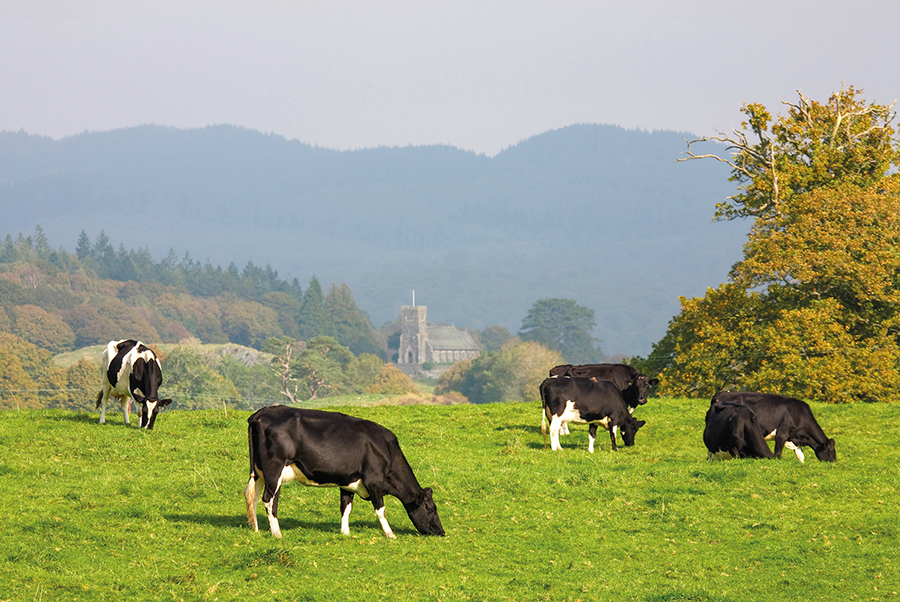Warning over mineral levels after wet weather
28th June 2024
After a record-breaking wet winter and spring, mineral levels in grass could be reduced, putting livestock at risk of deficiencies. Sarah Kidby reports.

A recent podcast saw experts discuss the impact of exceptionally wet weather on mineral levels. With land sitting underwater for prolonged periods, key issues include oxygen levels, uptake of minerals by the plant and compaction. Dr Alison Bond, technical services manager for Rumenco and Nettex, said there could also be an increase in the uptake of some heavy metals, including molybdenum and iron, which affect the availability of major minerals such as magnesium, calcium and phosphorus.
Very wet soil also means potential for poaching and soil contamination, added Lisa Hambly, head of grassland and forage agronomy at Mole Valley Farmers. Dairy farmers will also have had problems with large amounts of slurry accumulating, with later application resulting in increased contamination risk. Testing that grass is vital, though it provides only a snapshot, she added. If you know your soils have a problem with over or undersupply these conditions are going to highlight that.
Rapid grass growth triggered by warm sunny days later in spring and early summer, could also have a dilution effect for minerals such as cobalt and magnesium, Dr Bond continued, and this affects lamb growth rates, and puts animals at higher risk of grass staggers. Additionally, low dry matter means the grass is moving through the animal more quickly, so not all available magnesium will be absorbed. High nitrogen and potash levels compound the issue, and a supplement is recommended in these cases. Animals don’t store magnesium very well so they need a daily top up, particularly in the risk period at spring turnout – and potentially again in the autumn.
What tests are available?
Ms Hambly advised carrying out slurry testing, and looking at five yearly soil tests, preferably broad spectrum, or if not, animal health soil tests, which offer the added benefit of measuring selenium and cobalt. Grass tissue analysis gives you an idea of how the soil profile is being taken up within the crop, while fresh grass tests are like an MOT and provide a snapshot on that particular day.
Dr Bond advised taking lots of samples – perhaps in a W or an X shape – and pooling them all together. Don’t take them all from areas you expect to be contaminated, or from areas where cows don’t eat. Such tests can help to build up a picture over a number of years as to what’s going on in the fields. Blood testing cattle also has a place, but tends to demonstrate the short-term rather than the long-term picture.
Signs of mineral deficiency tend to be low level – poor fertility, not hitting targets in terms of getting back in calf, or generally being ‘unthrifty’. Sometimes extreme copper deficiency may result in darker coloured animals, rings round eyes, and pigmentation issues. Extreme selenium deficiency is likely to manifest as white muscle disease, animals struggling, muscle aches, nervousness, twitchiness.
Supplementation options
Magnesium has a bitter taste, so if it’s given in water, it’s important to ensure animals can’t access any other water sources. Aside from adding to compound feed, options for magnesium supplementation include offering it with free access molasses, which also takes care of the palatability issue. Or, it can be given in buckets and blocks which are a good insurance policy in risky periods, and many are molasses-based, Dr Bond said.
Calcium, and the balance with magnesium, is absolutely critical, Ms Hambly added. One of the easiest ways to improve calcium levels in the crop is getting the pH right – if pH is low, add lime to the crop.
Looking at supplementation more generally, boluses offer a long-lasting supply of trace elements, orally administered so you know every animal has received it – and some last 4-6 months. However, the animal handling required will not suit all farms and boluses often only contain the trace elements, so if you’re concerned about magnesium or calcium, they may not be the ideal supplement. However, they work very well for extensive grazing systems, she added.
Blocks and buckets often include a good complement of the minor and major elements and are easy to administer, but with so many options on the market, it can be a minefield. Loose minerals are also common, and can be free access, top dressed or mixed through a ration, allowing more bespoke minerals.
When choosing what to supplement, Dr Bond advised looking at every different input on your farm, e.g. through forage mineral analysis, speaking to your cake supplier to find out if any minerals are included, and considering any drenches and boluses given. Consider what you’re supplying and what the animal requires and balance the two – because oversupply can be just as problematic as undersupply. A lot of animals cannot store these minerals, and phos is a prime example – it’s an expensive element that becomes an expensive pollutant if it’s oversupplied. Overall, it’s about considering what will work for you in terms of labour and your animals’ requirements.
On choosing from the myriad of different products, she recommended having a really good look at the label. Understand what’s in the supplement, what it will supply, and if you’re looking at boluses and drenches, what is the daily supply and how long will it last. Don’t be frightened to ask your rep for the information you need.
Read more livestock news
